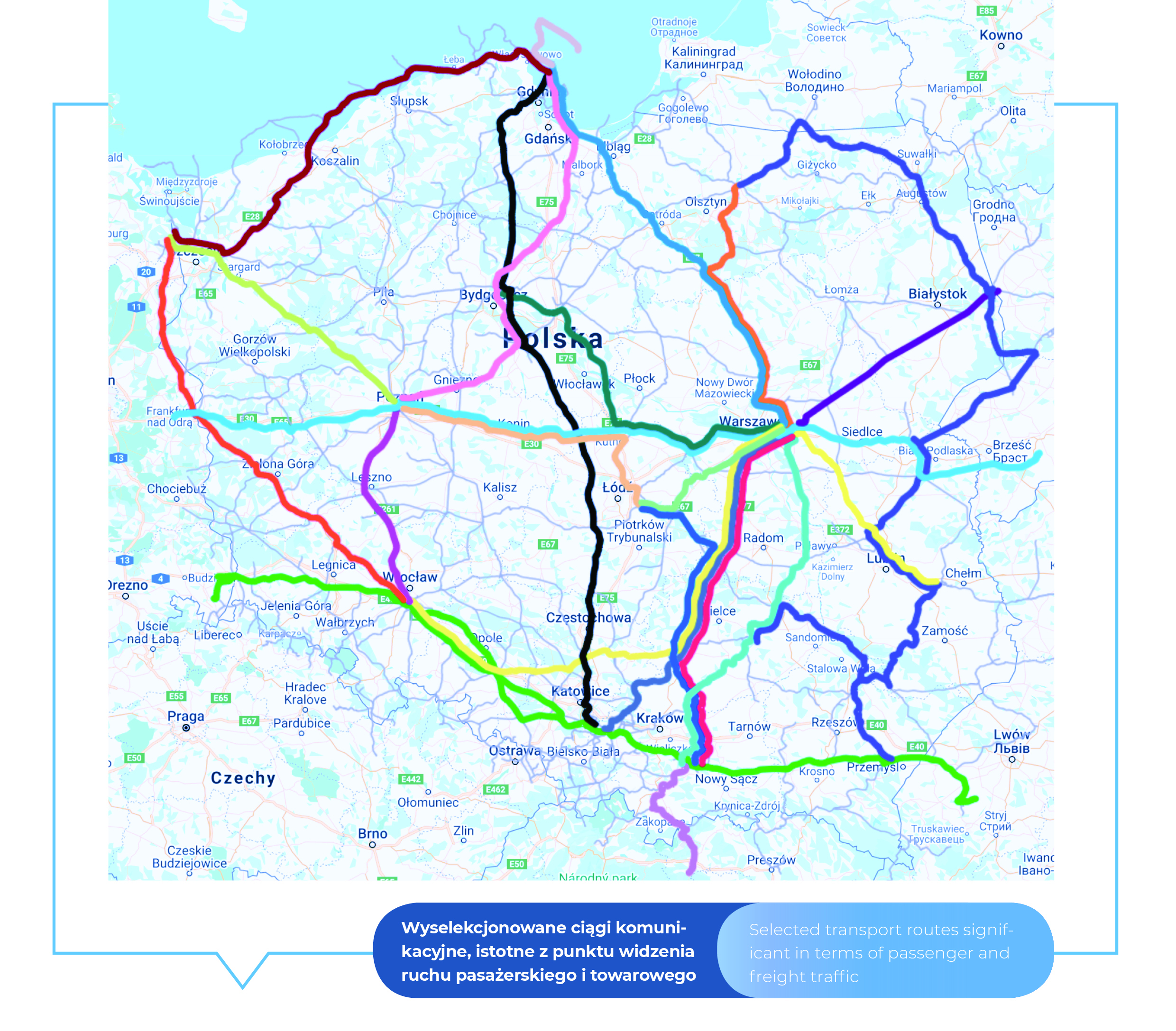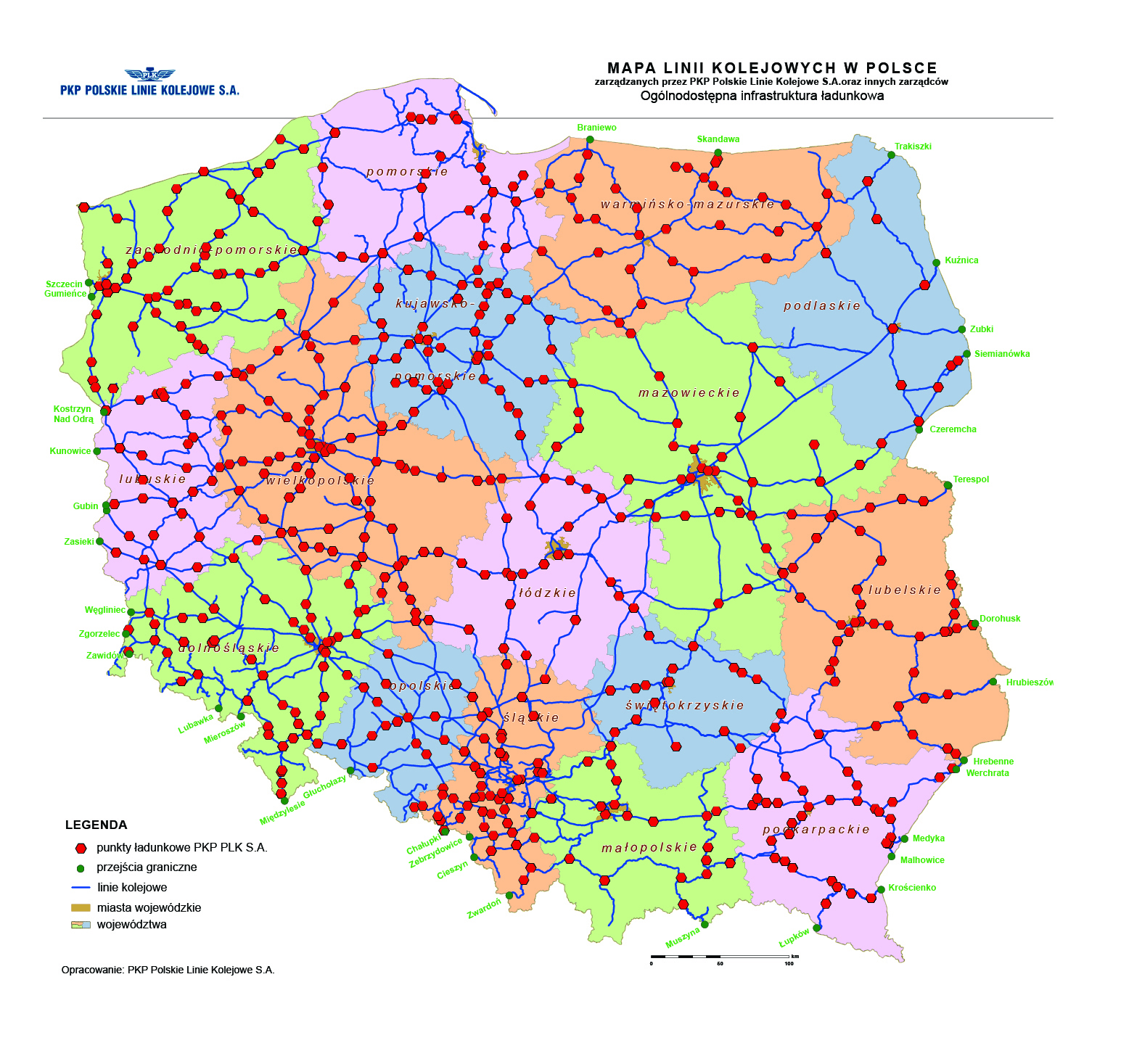
Installation of a turnout at Grodzisk Mazowiecki Station
Railways in Poland
December 29, 2020

Installation of a turnout at Grodzisk Mazowiecki Station
Lines in operation
The length of electrified railway lines used by all infrastructure operators in Poland was 12 017 km in 2019. The lines of national significance were administered only by PKP PLK, accounting for 69% of lines used by the company and 65% of all railway lines in Poland. The length of the lines of national significance increased by 100 km in comparison to that in 2018. The total length of double-track lines was 8813 km at the end of 2019. Single-track railway lines are still predominant in Poland, which in many cases gives rise to problems related to capacity. A definite majority (91%) of double-track lines are electrified, whereas single-track lines are mostly non-electrified (62%). All the wide-gauge railway lines in Poland are single-track.
The mean density of railway lines in 2019 was 6.24 km/100 km². The largest increase in the length of lines took place in Podlaskie voivodeship (26 km) and Lubusz voivodeship (25 km). The lines are the densest in Silesian voivodeship (15.7 km/100 km2), and the least dense in Podlaskie voivodeship (3.8 km/100 km2). Out of all voivodeships, Silesian voivodeship had the largest share in the length of the railway network (10.1%), and Świętokrzyskie voivodeship (3,7%) had the smallest share.

Recently, the admissible railway speed has been growing systematically. In Poland, tracks with the lowest parameters according to permissible speed still have a large share. In 2019, routes on which the maximum speed was 60 km/h accounted for approx. 23%, and from 60 to 80 k m/h - for more than 15%. For passenger connections between voivodeships, speeds from 80 to 120 km/h are often insufficient to complete the services, and the desired speed is from 120 to 160 km/h. Recently, due to modernisation works, the share of railway lines with permissible axle load of 221 kN and at the end of 2019 it was 60.4%. Infrastructure with permissible axle load of less than 200 kN accounted for 23% of the whole length of tracks in Poland.
Railway line managers
The largest infrastructure manager is PKP PLK that in 2019 managed 18 679 km active lines and 1858 km of decommissioned lines. The longest network of wide-gauge lines (395 km) was managed by the company PKP LHS. In addition to the main railway manager in Poland, PKP PLK, other infrastructure managers are: CTL Maczki-Bór, DSDiK, Euroterminal Sławków, Infra Silesia, KP KOTLARNIA – Linie Kolejowe, Pomeranian Metropolitan Railway, PMT Linie Kolejowe, Cargotor, JSK and UBB Polska. In addition, some companies present on the market combine the function of the railway manager and carrier by managing railway infrastructure and providing railway carriages only for the purposes of urban or suburban railway transport and carriages on a wide-gauge line. These are: PKP SKM, WKD and PKP LHS.
In 2019, revenues of managers increased once again in comparison to the previous year. PKP PLK received a grant (including resources from the Railway Fund) amounting to PLN 3.9 billion. The costs of operating activity of managers increased to the record-breaking level of PLN 700 billion. According to the Investment Plan of the Company, PKP PLK completed projects financed from the resources of the Cohesion Fund, state budget, Railway Fund and the company’s own funds.
Infrastructure of PKP PLK:
At the end of 2019, managers of the railway lines infrastructure employed 40 617 people. Most of them (more than 96%) worked for the largest infrastructure manager – PKP PLK.
Workers in positions directly connected with train traffic are nearly half of all the infrastructure managers’ employees.

A map of railway lines in Poland
RAILWAY TRANSSHIPMENT TERMINALS
In 2019 in Poland there were 39 intermodal transport terminals covering an area of ca. 524.3 ha. Their potential annual throughput capacity in 2019 was 9 047 240 TEU, and its loading surface was 196 449 TEU. In 2019, the storage market noted a significant increase (23%) in the supply of storage surface compared with the previous value. The warehousing and industrial facilities cover an area of ca. 18.6 million m2. The biggest potential –nearly 4.5 million m2 – is in Warsaw and its vicinity, while 3.5 million m2 of area is available in Upper Silesia.
PKP Cargo is the second largest freight carrier in the EU having at its disposal:
The latest intermodal investment of PKP CARGO is Poznań-Franowo terminal at the interface of important transport routes. The terminal is the largest freight station in Greater Poland. The area of the depot is about 20,000 m², and the total length of tracks is 1.57 km. The estimated transshipment capacity of the terminal is 60,000 TEU. Poland also has an intermodal Container Terminal Clip in Swarzędz. It is situated on the route of the main transport corridor on line E-30 (Rotterdam, Antwerp, Warsaw, Moscow, Beijing) and near the S5 expressway and A2 highway.